
West Country Carnival
Encyclopedia
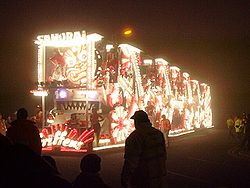
_by_gremlins_cc.jpg)
Parade
A parade is a procession of people, usually organized along a street, often in costume, and often accompanied by marching bands, floats or sometimes large balloons. Parades are held for a wide range of reasons, but are usually celebrations of some kind...
of illuminated floats
Float (parade)
A float is a decorated platform, either built on a vehicle or towed behind one, which is a component of many festive parades, such as those of Mardi Gras in New Orleans, the Carnival of Viareggio, the Maltese Carnival, the Macy's Thanksgiving Day Parade, the Key West Fantasy Fest parade, the...
(also referred to as carts), in the English West Country
West Country
The West Country is an informal term for the area of south western England roughly corresponding to the modern South West England government region. It is often defined to encompass the historic counties of Cornwall, Devon, Dorset and Somerset and the City of Bristol, while the counties of...
. The celebration dates back to the Gunpowder Plot
Gunpowder Plot
The Gunpowder Plot of 1605, in earlier centuries often called the Gunpowder Treason Plot or the Jesuit Treason, was a failed assassination attempt against King James I of England and VI of Scotland by a group of provincial English Catholics led by Robert Catesby.The plan was to blow up the House of...
of 1605. The purpose is to raise money for local charities
Charitable organization
A charitable organization is a type of non-profit organization . It differs from other types of NPOs in that it centers on philanthropic goals A charitable organization is a type of non-profit organization (NPO). It differs from other types of NPOs in that it centers on philanthropic goals A...
.
The series of parades in each town now form a major regional festival. Some carts cost in excess of £20,000 to build and are the result of thousands of hours work throughout the year.
History
The timing of the West Country Carnival close to the British celebration of Bonfire nightGuy Fawkes Night
Guy Fawkes Night, also known as Guy Fawkes Day, Bonfire Night and Firework Night, is an annual commemoration observed on 5 November, primarily in England. Its history begins with the events of 5 November 1605, when Guy Fawkes, a member of the Gunpowder Plot, was arrested while guarding...
on 5 November is no coincidence, as the roots of the original carnival in Bridgwater
Bridgwater
Bridgwater is a market town and civil parish in Somerset, England. It is the administrative centre of the Sedgemoor district, and a major industrial centre. Bridgwater is located on the major communication routes through South West England...
date back to 1605.
Guy Fawkes
Guy Fawkes
Guy Fawkes , also known as Guido Fawkes, the name he adopted while fighting for the Spanish in the Low Countries, belonged to a group of provincial English Catholics who planned the failed Gunpowder Plot of 1605.Fawkes was born and educated in York...
is the character most associated with the plot to blow up the Houses of Parliament, however the instigator was Jesuit
Society of Jesus
The Society of Jesus is a Catholic male religious order that follows the teachings of the Catholic Church. The members are called Jesuits, and are also known colloquially as "God's Army" and as "The Company," these being references to founder Ignatius of Loyola's military background and a...
priest Robert Parsons from Nether Stowey
Nether Stowey
Nether Stowey is a large village in the Sedgemoor district of Somerset, South West England. It sits in the foothills of the Quantock Hills , just below Over Stowey...
, a short distance from Bridgwater. Parsons and his colleagues Edmund Campion
Edmund Campion
Saint Edmund Campion, S.J. was an English Roman Catholic martyr and Jesuit priest. While conducting an underground ministry in officially Protestant England, Campion was arrested by priest hunters. Convicted of high treason by a kangaroo court, he was hanged, drawn and quartered at Tyburn...
and Ralph Emerson were Catholic
Roman Catholic Church
The Catholic Church, also known as the Roman Catholic Church, is the world's largest Christian church, with over a billion members. Led by the Pope, it defines its mission as spreading the gospel of Jesus Christ, administering the sacraments and exercising charity...
s, who wanted to put an end to the Protestant monarchy and parliament of the day, in order to put an end to Catholic persecution. In 1580, they were discovered attempting to garner favour with northern-English based nobility in the English Mission, and were then associated with the failed Spanish Armada
Spanish Armada
This article refers to the Battle of Gravelines, for the modern navy of Spain, see Spanish NavyThe Spanish Armada was the Spanish fleet that sailed against England under the command of the Duke of Medina Sidonia in 1588, with the intention of overthrowing Elizabeth I of England to stop English...
of 1588, both plots to replace protestant Elizabeth I of England
Elizabeth I of England
Elizabeth I was queen regnant of England and Ireland from 17 November 1558 until her death. Sometimes called The Virgin Queen, Gloriana, or Good Queen Bess, Elizabeth was the fifth and last monarch of the Tudor dynasty...
with catholic Mary Queen of Scots. After the deaths of Campion and Emerson, Parsons continued to plot to restore Catholic power in England, and hence his last ill-fated attempt against parliament and King James VI on 5 November 1605. After the failure of the Gunpower Plot, Parsons was key in corresponding with Thomas Morton
Thomas Morton (bishop)
Thomas Morton was an English churchman, bishop of several dioceses.-Early life:Morton was born in York on 20 March 1564. He was brought up and grammar school educated in the city and nearby Halifax. In 1582 he became a pensioner at St John's College, Cambridge from which he graduated with a BA in...
over the authority of use of St Paul in the creation and implementation of the Jacobean Oath of Allegiance.
Bonfire night
Guy Fawkes Night
Guy Fawkes Night, also known as Guy Fawkes Day, Bonfire Night and Firework Night, is an annual commemoration observed on 5 November, primarily in England. Its history begins with the events of 5 November 1605, when Guy Fawkes, a member of the Gunpowder Plot, was arrested while guarding...
is a major annual celebration across the whole of England, but it is likely that the reason that the West Country Carnival was originally so keenly celebrated is that the South West
West Country
The West Country is an informal term for the area of south western England roughly corresponding to the modern South West England government region. It is often defined to encompass the historic counties of Cornwall, Devon, Dorset and Somerset and the City of Bristol, while the counties of...
towns were predominantly Protestant – hence the celebration of Robert Parsons' (and Guy Fawkes') failure. The religious origins of the event are almost forgotten and far less significant today
Bridgwater
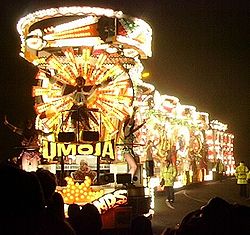
Bridgwater
Bridgwater is a market town and civil parish in Somerset, England. It is the administrative centre of the Sedgemoor district, and a major industrial centre. Bridgwater is located on the major communication routes through South West England...
celebrations consisted of a large bonfire
Bonfire
A bonfire is a controlled outdoor fire used for informal disposal of burnable waste material or as part of a celebration. Celebratory bonfires are typically designed to burn quickly and may be very large...
at the Cornhill. Built out of a large wooden boat, around one hundred tar
Tar
Tar is modified pitch produced primarily from the wood and roots of pine by destructive distillation under pyrolysis. Production and trade in tar was a major contributor in the economies of Northern Europe and Colonial America. Its main use was in preserving wooden vessels against rot. The largest...
barrels where added, together with just about anything else available which could be burned. This tradition was stopped due to lack of old wooden boats to burn, and because a number of good boats were thrown onto the fire and burnt by over-enthusiastic revellers.
Effigies or "guys" representing the gunpowder plot instigators were added to the fire by local groups of people known as gangs. It would seem it was these gangs who started the trend towards a procession, as they paraded their guys towards the bonfire. As years passed by, the tradition was continued and the annual celebration became more and more elaborate, involving costumes and music, until the key feature of the event was a large carnival procession.
The local people who dressed up and took part in the event were known as Masqueraders or Features - terms still used today to describe the parade participants.
There were no parades during the Second World War, but a local carnival enthusiast William Henry Edwin Lockyer also known as "Nosey" walked the carnival route for six years with a group known as The Kilties, to keep the tradition alive.
Squibbing
In addition to the carnival procession, the tradition of "squibbing" still occurs after the procession ends. A squibSquib (explosive)
A squib is a miniature explosive device used in a wide range of industries, from special effects to military applications. It resembles a tiny stick of dynamite, both in appearance and construction, although with considerably less explosive power...
locally is a firework which is held aloft by a person known as a "squibber" on the end of a long wooden handle called a "cosh". One hundred squibbers stand in line in Bridgwater
Bridgwater
Bridgwater is a market town and civil parish in Somerset, England. It is the administrative centre of the Sedgemoor district, and a major industrial centre. Bridgwater is located on the major communication routes through South West England...
town centre making an unusual but impressive sight for visitors who crowd the High Street.
Originally the squibs were made specially for the carnival and were known as the Bridgwater Squib, and culminated with a large bang as each squib extinguished. With modern Health and Safety concerns it has become difficult to purchase such squibs, and owing to the rising cost of insurance the present-day squib's have no bang.
Lines of flammable liquid are also run along the ground by the squibbers and lit to add to the spectacle. Visitors often think the whole sight looks a little dangerous, but the event is well organised and nobody has been hurt to date.
Modern times
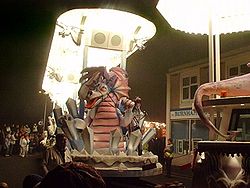
Bridgwater carnival now consists of a display of over 100 large vehicles up to 100 feet (30 m) long, festooned with dancers and up to 22,000 lightbulbs, that follows a 2.5 miles (4 km) route over two to three hours. 2005 included the Masquerade 2000 entrants from Notting Hill Carnival
Notting Hill Carnival
The Notting Hill Carnival is an annual event which since 1964 has taken place on the streets of Notting Hill, Royal Borough of Kensington and Chelsea , London, UK each August, over two days...
.
Bridgwater now attracts around 150,000 people from around the West Country, UK and globally. Parking from the M5 is well sign posted and plentiful, and managed by the committee in association with Avon and Somerset Police
Avon and Somerset Constabulary
Avon & Somerset Constabulary is the territorial police force in England responsible for policing the non-metropolitan county of Somerset, the city & county of Bristol and the unitary authorities of South Gloucestershire, North Somerset and Bath and North East Somerset; before 1996 these districts...
. Public access grandstands were introduced in the mid-1990s, which have increased in popularity over recent years.
The carnival's purpose is to raise money for local charities from money collection carts in the procession. Between 2003 and 2007, around £115,000 was raised at Bridgwater Carnival.
In 2010, the Heritage Lottery Fund
Heritage Lottery Fund
The Heritage Lottery Fund is a fund established in the United Kingdom under the National Lottery etc. Act 1993. The Fund opened for applications in 1994. It uses money raised through the National Lottery to transform and sustain the UK’s heritage...
awarded the Carnival in Somerset Promotion Project £41,000 to promote and conserve carnival heritage.
Carnival concert
The carnival concert takes place in the weeks leading up to the carnival. At these concerts, carnival clubs perform on stage wearing their costumes and using pieces of scenery taken from their carts. After being poorly patronised for a period, the carnival concert has become a highly popular attraction in recent years, with tickets to see the event in a Bridgwater hall selling out very quickly – partly due to increased publicity, and partly as the popularity of the carnival increases it is an easy access way to see the carnival over more daysCalendar changes
The Bridgwater carnival had traditionally been held on Bonfire nightGuy Fawkes Night
Guy Fawkes Night, also known as Guy Fawkes Day, Bonfire Night and Firework Night, is an annual commemoration observed on 5 November, primarily in England. Its history begins with the events of 5 November 1605, when Guy Fawkes, a member of the Gunpowder Plot, was arrested while guarding...
, or 5 November. This was then formalised in 1919 after the First World War, as the carnival circuits were formed to be held on the first Thursday of November – Thursday was traditionally early closing day for shops in Bridgwater.
Local Government Authorities and businesses were keen to the reschedule the event to a weekend date – presumably to make it more convenient for visitors to attend. This met strong resistance from many locals who believe the tradition of so many years should be maintained, and from others who are concerned that the new timing could affect the ability of clubs to participate in other local carnival processions – North Petherton
North Petherton
North Petherton is a small town and civil parish in Somerset, England, situated on the edge of the eastern foothills of the Quantocks, and close to the edge of the Somerset Levels.The town has a population of 5,189...
carnival has traditionally taken place on the following Saturday. The new timing would also spoil another local tradition known as Black Friday, when locals celebrate their hard work on carnival in an alcoholic manner.
However, accepting that shops and work times in the present have changed greatly and the local economic business need, the Bridgwater Carnival Committee decided, not without much controversy, to move the carnival to a Friday with effect from 2001. This was part of a strategy to keep the carnival alive in the long term, with the committee working with Sedgemoor District Council
Sedgemoor
Sedgemoor is a low lying area of land in Somerset, England. It lies close to sea level south of the Polden Hills, historically largely marsh . The eastern part is known as King's Sedgemoor, and the western part West Sedgemoor. Sedgemoor is part of the area now known as the Somerset Levels...
to provide entertainment for visitors from mid-day on carnival day.
The dates will change again from 2012, with Bridgwater on the first Saturday in November. It is hoped that as a result of the changed date many visitors will come earlier and stay longer, perhaps taking in some of the other carnivals and entertainment provided locally.
Carnival circuit
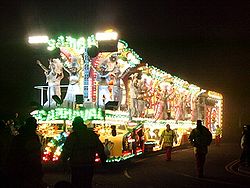
The three circuits are:
- Wessex Grand Prix Circuit: Sturminster NewtonSturminster NewtonSturminster Newton, known to locals as Stur, is a town in the Blackmore Vale area of Dorset, England. It is situated on a low limestone ridge in a meander of the River Stour. The town is at the centre of a large dairy agriculture region, around which the town's economy is built...
, the third Thursday in August/weekend before Bank Holiday; MereMere, WiltshireMere is a small town in Wiltshire, England. It lies at the extreme southwestern tip of Salisbury Plain close to the borders of Somerset and Dorset....
; FromeFromeFrome is a town and civil parish in northeast Somerset, England. Located at the eastern end of the Mendip Hills, the town is built on uneven high ground, and centres around the River Frome. The town is approximately south of Bath, east of the county town, Taunton and west of London. In the 2001...
; ShaftesburyShaftesburyShaftesbury is a town in Dorset, England, situated on the A30 road near the Wiltshire border 20 miles west of Salisbury. The town is built 718 feet above sea level on the side of a chalk and greensand hill, which is part of Cranborne Chase, the only significant hilltop settlement in Dorset...
; GillinghamGillingham, DorsetGillingham is a town in the Blackmore Vale area of Dorset, England. The town is the most northerly in the county. It is 3 miles south of the A303 lying on the B3092 and B3081. It is near to the town of Shaftesbury which lies 7 miles to the south east. Neighbouring hamlets included Peacemarsh, Bay...
; Castle Cary & AnsfordCastle CaryCastle Cary is a market town and civil parish in south Somerset, England, north west of Wincanton and south of Shepton Mallet.The town is situated on the River Cary, a tributary of the Parrett.-History:...
; SalisburySalisburySalisbury is a cathedral city in Wiltshire, England and the only city in the county. It is the second largest settlement in the county...
; TrowbridgeTrowbridgeTrowbridge is the county town of Wiltshire, England, situated on the River Biss in the west of the county, approximately 12 miles southeast of Bath, Somerset....
; WarminsterWarminsterWarminster is a town in western Wiltshire, England, by-passed by the A36, and near Frome and Westbury. It has a population of about 17,000. The River Were runs through the town and can be seen running through the middle of the town park. The Minster Church of St Denys sits on the River Were... - South Somerset Federation Of Carnival Committee Circuit: WellingtonWellington, SomersetWellington is a small industrial town in rural Somerset, England, situated south west of Taunton in the Taunton Deane district, near the border with Devon, which runs along the Blackdown Hills to the south of the town...
held on the last Saturday in September; IlminsterIlminsterIlminster is a country town and civil parish in the countryside of south west Somerset, England, with a population of 4,781. Bypassed a few years ago, the town now lies just east of the intersection of the A303 and the A358...
; ChardChard, SomersetChard is a town and civil parish in the Somerset county of England. It lies on the A30 road near the Devon border, south west of Yeovil. The parish has a population of approximately 12,000 and, at an elevation of , it is the southernmost and highest town in Somerset...
; TauntonTauntonTaunton is the county town of Somerset, England. The town, including its suburbs, had an estimated population of 61,400 in 2001. It is the largest town in the shire county of Somerset....
; - Somerset County Guy Fawkes Carnival Association Circuit: BridgwaterBridgwaterBridgwater is a market town and civil parish in Somerset, England. It is the administrative centre of the Sedgemoor district, and a major industrial centre. Bridgwater is located on the major communication routes through South West England...
on the Friday following the nearest Thursday to 5 November; North PethertonNorth PethertonNorth Petherton is a small town and civil parish in Somerset, England, situated on the edge of the eastern foothills of the Quantocks, and close to the edge of the Somerset Levels.The town has a population of 5,189...
on the following Saturday; Burnham-on-SeaBurnham-on-SeaBurnham-on-Sea is a town in Somerset, England, at the mouth of the River Parrett and Bridgwater Bay. Burnham was a small village until the late 18th century, when it began to grow because of its popularity as a seaside resort. It forms part of the parish of Burnham-on-Sea and Highbridge...
on the following Monday; Shepton MalletShepton MalletShepton Mallet is a small rural town and civil parish in the Mendip district of Somerset in South West England. Situated approximately south of Bristol and east of Wells, the town is estimated to have a population of 9,700. It contains the administrative headquarters of Mendip District Council...
on the following Wednesday; WellsWellsWells is a cathedral city and civil parish in the Mendip district of Somerset, England, on the southern edge of the Mendip Hills. Although the population recorded in the 2001 census is 10,406, it has had city status since 1205...
on the following Friday; Glastonbury & ChilkwellGlastonburyGlastonbury is a small town in Somerset, England, situated at a dry point on the low lying Somerset Levels, south of Bristol. The town, which is in the Mendip district, had a population of 8,784 in the 2001 census...
on the following Saturday; Weston-super-MareWeston-super-MareWeston-super-Mare is a seaside resort, town and civil parish in the unitary authority of North Somerset, which is within the ceremonial county of Somerset, England. It is located on the Bristol Channel coast, south west of Bristol, spanning the coast between the bounding high ground of Worlebury...
on the following Monday, the last carnival in the whole circuit- Circuit from 2012: Bridgwater on the first Saturday in November; Weston-super-Mare on the following Friday; North Petherton on the second Saturday; Burnham-on-Sea on the following Monday; Shepton Mallet on the following Wednesday; Wells on the third Friday; and Glastonbury on the third Saturday.
There is one unofficial carnival in the circuit, the Midsomer Norton
Midsomer Norton
Midsomer Norton is a town near the Mendip Hills in Somerset, England, south-west of Bath, north-east of Wells, north-west of Frome, and south-east of Bristol. It has a population of 10,458. Along with Radstock and Westfield it used to be part of the conurbation and large civil parish of Norton...
carnival held at Westfield
Westfield, Somerset
Westfield is a settlement lying on the Fosse Way between Radstock and Midsomer Norton in Somerset, England. In 2011 it was raised to the status of a civil parish....
on the Thursday between the Shepton Mallet and Wells carnivals. There is also a series of carnivals, including Ashburton
Ashburton, Devon
Ashburton is a small town on the edge of Dartmoor in Devon, adjacent to the A38 Devon Expressway.It was formerly important as a stannary town , and remains the largest town within the National Park, with a population of around 3,500...
, Blandford Forum, Cullompton
Cullompton
Cullompton is a civil parish and town in Devon, England, locally known as Cully. It is miles north-north-east of Exeter and lies on the River Culm. In 2010 it had a population of 8,639 and is growing rapidly....
, Melksham
Melksham
Melksham is a medium-sized English town, lying on the River Avon. It lies in the county of Wiltshire.It is situated southeast of the city of Bath, south of Chippenham, west of Devizes and north of Warminster on the A350 national route. The 2001 UK census cited Melksham as having 20,000...
, South Brent
South Brent
South Brent is a large village on the southern edge of Dartmoor, England, in the valley of the River Avon, population 2998 , 8 km north-east of Ivybridge, and next to the Devon Expressway which connects Exeter to the north-east and Plymouth to the west.-History:It was originally a woollen...
, South Petherton
South Petherton
South Petherton is a small country town and civil parish on the River Parrett in the South Somerset district of Somerset, England. It is east of Ilminster and north west of Crewkerne. It had a population of approximately 3,200 in 2002...
, Tiverton, Topsham
Topsham, Devon
Topsham is a suburb of Exeter in the county of Devon, England, on the east side of the River Exe, immediately north of its confluence with the River Clyst and the former's estuary, between Exeter and Exmouth. Although village-sized, with a current population of around 5,023, it was designated a...
, Torquay
Torquay
Torquay is a town in the unitary authority area of Torbay and ceremonial county of Devon, England. It lies south of Exeter along the A380 on the north of Torbay, north-east of Plymouth and adjoins the neighbouring town of Paignton on the west of the bay. Torquay’s population of 63,998 during the...
.
Carts and floats
Uniquely in the West Country, the vehicles are called carts, unlike other carnivals where the term carnival floatFloat (parade)
A float is a decorated platform, either built on a vehicle or towed behind one, which is a component of many festive parades, such as those of Mardi Gras in New Orleans, the Carnival of Viareggio, the Maltese Carnival, the Macy's Thanksgiving Day Parade, the Key West Fantasy Fest parade, the...
is used. The term cart is still used today to describe the large and elaborate trailers used in the procession. Carts are built by local clubs of individuals funded totally by charitable donations and sponsorship from local businesses.
Carts are always themed, with no restriction on the theme from the organising committee. Regularly chosen themes include:
- Popular children's books - like Alice in Wonderland
- Favourite children's characters - such as Disney characters
- Scenes or themes from history - like Pre-Historic, VictorianVictorian eraThe Victorian era of British history was the period of Queen Victoria's reign from 20 June 1837 until her death on 22 January 1901. It was a long period of peace, prosperity, refined sensibilities and national self-confidence...
or famous BattleBattleGenerally, a battle is a conceptual component in the hierarchy of combat in warfare between two or more armed forces, or combatants. In a battle, each combatant will seek to defeat the others, with defeat determined by the conditions of a military campaign...
s - Scenes or themes from around the world - such as Australia, Rio de JaneiroRio de JaneiroRio de Janeiro , commonly referred to simply as Rio, is the capital city of the State of Rio de Janeiro, the second largest city of Brazil, and the third largest metropolitan area and agglomeration in South America, boasting approximately 6.3 million people within the city proper, making it the 6th...
or Spanish - Travel and transport - such as cars or trains, e.g., The Chattanooga Choo-Choo
- Popular themes of the day - including pop songs or dances
- The future or exploration - such as space
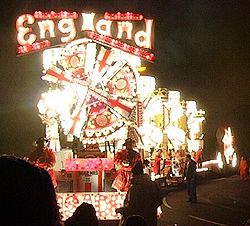
Tableau vivant
Tableau vivant is French for "living picture." The term describes a striking group of suitably costumed actors or artist's models, carefully posed and often theatrically lit. Throughout the duration of the display, the people shown do not speak or move...
.
Today these carts are driven by farm tractor
Tractor
A tractor is a vehicle specifically designed to deliver a high tractive effort at slow speeds, for the purposes of hauling a trailer or machinery used in agriculture or construction...
s, and usually also tow a large diesel-driven electricity generator to provide the huge amount of power required to power the carts. Some generators used can provide over one megawatt of power, with 10,000 to 30,000 light bulbs not uncommon on a modern-day cart. The tractors themselves are often decorated to match the rest of the cart and generator, and in some cases modified so that the driver is positioned low down between the two front wheels. This allows for a higher degree of decoration without obscuring the driver's view. The length of the entire cart is often built to the maximum allowable of 100 feet (30 m).
These floats are interspersed with walking exhibits, either groups or singles, occasional marching bands or majorette troupes, and charity collectors who take donations from the spectators.
Carnival clubs
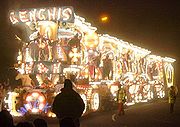
Charitable organization
A charitable organization is a type of non-profit organization . It differs from other types of NPOs in that it centers on philanthropic goals A charitable organization is a type of non-profit organization (NPO). It differs from other types of NPOs in that it centers on philanthropic goals A...
themselves are aimed specifically and solely at raising funds for other charities which operate within their locality. Clubs generate all funds required to build and operate their carts totally by charitable donations from individuals and sponsorship from local businesses - all funds raised during the carnival season are wholly distributed by the club charity. Some carts cost in excess of £20,000 to build and are the result of thousands of man-hours work throughout the year. Most clubs are based around local working or social circles, such as pubs and clubs. Many clubs have specialist Juvenile Carnival clubs for the under 18s. To join an adult 18 and over club, an initiation ceremony is often involved. All work is carried out in the spare time of the club members on a voluntary basis – often working all night in the final few days to get carts ready.

